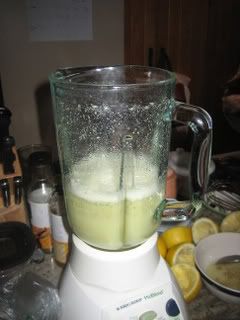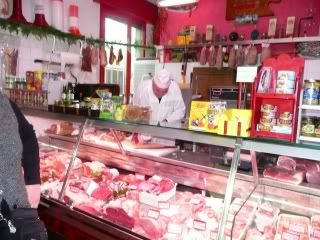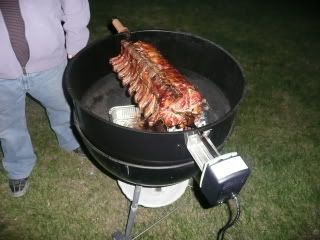
Slow cooked pork is a grand tradition around the world. Whether you're talking Carolina Pulled Pork, Hawaiian Kalua Pig, Cuban Lechon Asado or Italian Porchetta, it all comes down to a delightfully fatty piece of meat, seasoned well and slow cooked to perfection. I've been making Carolina style pulled pork in my smoker for several years now, but recently I decided to switch up my seasoning a little and came up with this Italian-American fusion which my friends and family rave about. It takes a long time to make, but the actual steps are quite easy. This dish is great reheated, so don't be afraid to cook it a day or two in advance. The basic process is as follows:
Step 1 - Brine meat overnight (brining seasons the inside of the meat and ensures that it will remain moist)
Step 2 - Rub with a spice blend
Step 3 - Slow cook until the meat reaches an internal temp of 195 degrees (I know this sounds high, but you need to reach that point for this tough but flavorful piece of meat to become tender enough to pull apart)
Step 4 - Rest until cool enough to handle and pull the meat apart into bite size pieces
Step 5 - Season to taste with salt, pepper and bbq sauce (some people like their pulled pork with a lot of sauce, but I prefer mine lightly dressed like a salad. You can serve extra sauce on the side for people who want it.)
Don't worry if you don't have a big meat smoker like mine, because you could make this same recipe in a regular oven (although it won't have the subtle smokey goodness that comes from the wood oven technique).
Ingredients:
1 (or in my case 6) bone in pork shoulder, a.k.a. Boston Butt
Kosher Salt
Brown Sugar
Black Pepper
Garlic Powder
Onion Powder
6 lemons
1 cup chicken stock
4 cloves garlic
3 tablespoons fresh rosemary leaves
1 tablespoon dried fennel seeds
red pepper flakes to taste (optional)
The day before you plan to cook the pork, prepare a brine of 1/2 cup kosher salt, 1/2 cup brown sugar and 1 gallon of cold water. Mix well until the salt and sugar dissolves. Place the shoulder(s) in a large zip-top storage bag, pour the brine over the top, seal the bag and place the bag in a large bowl or roasting pan and refrigerate overnight.

VERY EARLY THE NEXT MORNING, remove the meat from the brine, dry with paper towels and rub with a blend of equal parts garlic powder, onion powder and black pepper. Preheat the smoker (or oven) to 250-275 degrees and place the meat inside.

If using a smoker, place it on the rack with a large drip pan underneath. Remember this is a fatty piece of meat and slow cooking will render out alot of the grease. If cooking in the oven, place the meat on a rack in a large roasting pan. Depending on the temperature of your smoker/oven and the size and shape of the piece of meat, it will take between 8 and 12 hours to cook. The only way to know when it's done is with a meat thermometer. Remember that you are looking for in internal temp of 195 degrees. I usually start checking the temp after 6 hours. Don't check it constantly, because everytime you open the door to the smoker or oven, you are losing heat and increasing the cooking time. Once the meat is done cooking, remove it from the smoker/oven and rest it wrapped in foil for about 30-45 minutes. While it is cooling, prepare the sauce.

Juice all of the lemons, reserving three or four strips of the peel (zest only). Place the lemon juice, lemon peel, chicken stock, garlic, rosemary, fennel and a pinch of red pepper flakes in a blender and puree. Taste and adjust seasoning to your liking. Add salt and pepper as necessary. It should be citrusy, with a pronounced fennel/rosemary flavor.

When the meat is cool enough to handle, start pulling the meat apart, disposing of any connective tissue or large chunks of fat. I wear disposable food service gloves for sanitatary reasons and also to keep the greasy meat from building up under my fingernails.

Once the meat is separated into relatively uniform, bite size pieces, begin seasoning it. Taste a little first, then add some of the sauce followed by a sprinkling of salt and pepper if necessary. Mix the meat with your hands as if you were tossing a salad, then taste again. Continue adding the sauce and adjusting the seasoning until you are satisfied with the taste. Once it is seasoned, place it back in the smoker/oven to reheat for 30 to 45 minutes. If you are making it a day or two ahead, you can simply refrigerate it after seasoning it and then reheat in a 300 degree oven for 45 minutes on the day you are serving it.
Serve it as a main dish with your favorite contorni, or pile it onto a lightly toasted ciabatta role for the best pulled pork sandwhich ever!

















































